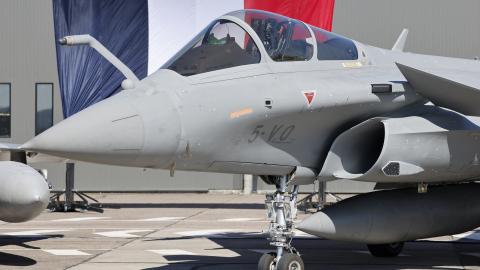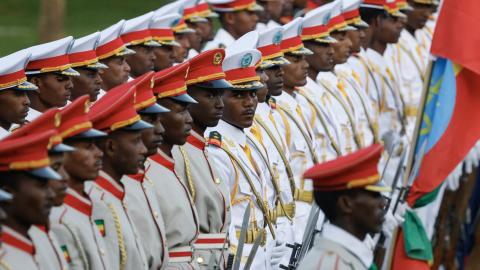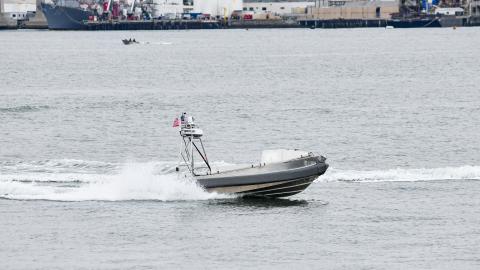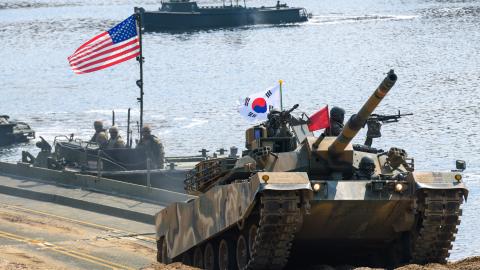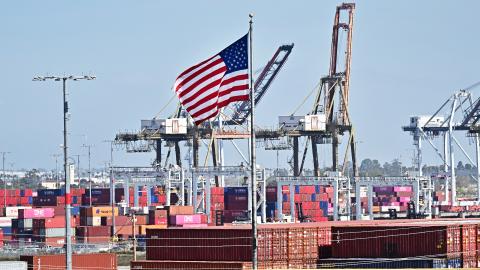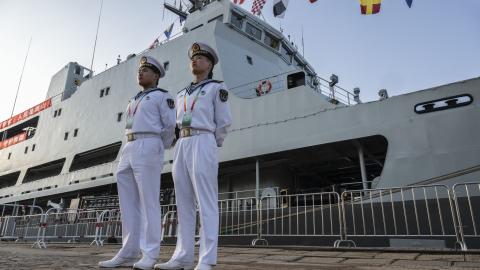On January 17th, Hudson Adjunct Fellow Michael Pregent testified before the House Oversight Committee's Subcommittee on National Security in a hearing titled "Battlefield Successes and Challenges - Recent Efforts to Win the War against ISIS."
Below are Mr. Pregent's written remarks:
Chairman DeSantis, Ranking Member Lynch, and distinguished members of the Subcommittee on National Security, on behalf of the Hudson Institute, I am honored to testify before you today about the successes against ISIS, and the challenges that remain.
Successes
Both the Obama and Trump administrations achieved success against ISIS. Under President Obama, ISIS lost the Mosul Dam, was defeated trying to take the Kurdish town of Kobane in Syria; and lost control of Tikrit, Ramadi, and Fallujah in Iraq. Under President Trump, ISIS lost its caliphate capitals of Mosul in Iraq and Raqqa in Syria, and its stronghold of Deir ez-Zor.
We learned early on that ISIS lost territory every time they’ve faced a capable ground force backed by US airpower. Two key examples of this happened early on in the campaign.
The first example of this was the battle over the Mosul Dam in 2014. There, Kurdish Peshmerga forces backed by US Special Forces and US air power retook control of the Mosul Dam and handed ISIS its first defeat.1
In October 2014, Secretary of State John Kerry indicated that “preventing the fall of the Syrian town of Kobane to Islamic State fighters was not a strategic U.S. objective.”2 Of course, Kobane was nothing if not strategic. A border town between Syria and Turkey, ISIS could have used it to profit from the black market oil trade and to facilitate foreign fighter flows in and out of Syria, not to mention that ISIS taking a Kurdish town while the world watched would help the terrorist army recruit.
Such situations underscored the incoherent approach the Obama administration brought to their understanding of how to contain and roll back ISIS. Without a broader strategy, the U.S. struggled to articulate its role in fighting ISIS.
As ISIS moved on Kobane, international media broadcasted ISIS maneuvers and artillery barrages on the city in broad daylight. Initially, Secretary Kerry did not see Kobane’s strategic value in defeating ISIS. Then, the administration authorized US Special Operations Forces (SOF) to call in airstrikes in support of Kurdish fighters – but from this, ISIS quickly adapted to our targeting windows when it became clear the U.S. would not strike during the day.
ISIS was allowed freedom of movement during the day – the group knew when we would hit, and when we wouldn’t.
Eventually, ISIS’s ability to reorganize its formations in Kobane during daytime hours embarrassed the administration and led to a partial reversal of the policy, allowing daytime strikes. But the incapacity for local commanders to make targeting decisions in the early stages of the fight against ISIS certainly enabled ISIS to take more territory.
One crucial lesson that emerged from both Kobane and the Mosul Dam was that the key to success in both cases was that the “Clear and Hold” force was from the area and had a vested interest in fighting to keep ISIS out. The most important aspect of a “Clear and Hold” strategy is the Hold phase that keeps ISIS and future iterations from coming back, but only when its government empowers it to do so.
After Kobane and Mosul Dam, the operations to take back Tikrit, Ramadi, Fallujah, and Mosul in Iraq were done with predominantly Shia forces in Sunni areas, which were the same forces that had lost that territory to begin with under Prime Minister Nouri al-Maliki. In other words, the “Clear” phase has been touted as a success, but the “Hold” phase will not hold without Sunni forces empowered by their central government to protect Sunni areas.
Obama and Trump Have Key Differences in Strategy, but Also Unfortunate Similarities
The Obama administration’s anti-ISIS strategy centralized decision making, resulting in lost opportunities to kill and capture targets of opportunity. It publicly touted victories hours after raids, killing the Intelligence Community’s ability to exploit the ISIS network after a successful “JackPot” – meaning a key leader was captured or killed. And it allowed the IRGC Quds force to increase its influence and presence in Iraq and Syria.
The Trump administration’s strategy has pushed resources and decision making down to the combatant commander, expanded our special operations missions to kill and capture key ISIS and Al-Qaeda leadership, and allowed the time for our intelligence agencies to exploit intelligence before touting success to the media and to the terrorist organizations themselves. Unfortunately, the Trump administration has also continued to stand by while the IRGC Quds force increases its influence and presence in Iraq and Syria.
PR Victory vs. Intelligence Win
The key change between the Trump and Obama administrations’ ISIS strategy is Strategic Patience when it comes to battlefield successes.
The Obama administration showed more interest in gaining PR victories than in gaining tactical or strategic intelligence victories. One of the biggest shifts in President Obama’s approach versus President Trump’s approach is that, under President Trump, after high-value targets are killed, the military often waits up to two weeks to publicly announce the successful operation. This allows intelligence analysts to comb through the target’s personal computer and effects, and to watch jihadi networks “light up” as the communication travels. This allows for follow-on raids based on the communication patterns they saw. Typically, the actionable intelligence and patterns dies down after a couple of weeks.
Under President Obama, however, immediate publicity of the killing was prioritized. After the Abu Sayyaf raid, for example, President Obama’s Administration waited only a handful of hours to announce the killing and the specific details of the raid.3 Announcing the death of one of ISIS’s top men immediately meant that ISIS leaders immediately burned their SIM cards and went to the mattresses – different mattresses, setting back intelligence efforts considerably.
There’s no better place to be than at the NSA after a raid to see a network light up – each selector with a geolocation our Special Operations Forces can strike. Under President Obama, this opportunity was repeatedly lost.
ROE Differences
**The Trump Strategy has relaxed the rules of engagement, and this has accelerated ISIS’s loss of territory.** Targeting authority has been moved down to the combatant commander - the operational commander, who has the best sense of the tactical situation on the ground. This makes sense. Both Secretary of Defense Jim Mattis and National Security Advisor H.R. McMaster were operational commanders who were trusted to make decisions without asking D.C. for permission. There would be no tactical hotline to the NSC under their watch. Targets of opportunity are being hit and again, without getting permission from thousands of miles away in the U.S. to conduct an attack.
Indeed, their predecessors Leon Panetta and Robert Gates also voiced frustrations with Obama’s National Security Council aides interfering in and micromanaging military decisions. Secretary Gates famously ripped out a phone line at the Joint Special Operations Command in Kabul that went straight to the NSC. “You get a call from the White House, you tell ‘em to go to hell and call me.”4
It wasn’t just interference. Obama-era rules of engagement (ROE) were very stringent, designed in part to avoid the potential loss of a pilot. The established framework was to strike targets at night, and only if there was a high certainty of hitting the right target while minimizing collateral damage. Furthermore, the Obama administration made the decision to avoid striking convoys carrying oil out of environmental concerns. Thus, ISIS was enabled to continue profiting enormously from the oil trade. The U.S. Treasury estimated ISIS made up to $500 million a year from oil in 2015.5
This risk aversion meant that targets had to be cleared by the National Security Council (NSC). However, targets of opportunity often disappear within seconds, and many of these targeting opportunities were lost. Furthermore, ISIS was able to continue making enough money to sustain itself. Thus, ISIS maintained the ability to move assets and oil around without being hit.
The Obama-era NSC employed a system of Centralized Targeting, which was fundamentally at odds with the windows of opportunity presented in which the U.S. could have incapacitated ISIS assets and leaders. This made prosecuting the fight against ISIS more difficult, as, to strike ISIS targets within the targeting window, approval authority must be at the ground level.
Destroying Sunni Cities to “Liberate” them from ISIS
The Rules of Engagement were relaxed when it came to taking back Ramadi. In 2015, Ramadi fell to 800 ISIS fighters as the numerically superior Iraqi Security Forces (ISF) withdrew. Ramadi had a population of 500,000 when the ISF withdrew and left it to 800 ISIS fighters, a number that later grew to 1,600. Eighty percent of Ramadi was destroyed in the ensuing campaign to retake the city, and the population became internally displaced refugees—all to defeat fewer than 1600 fighters.6
This is not what liberation looks like – this is what the destruction of a Sunni city looks like. Unfortunately, it continued with the Mosul operation under President Trump.
Mosul was left to ISIS for two and half years. ISIS was able to emplace sophisticated obstacle belts backed up by car bombs and snipers. They were able to wire buildings to explode, and took human shields.
Mosul, a Sunni city with a population of 1.6 million at the beginning of the operation, was heavily destroyed, and its residents pushed into the internally displaced refugee camps—all for an estimated four-thousand ISIS fighters who were allowed years to prepare their destructive defenses.7
The US and the ISF played a role in the destruction of Mosul as well. The coalition allowed IRGC-led militias to use crude artillery and rockets to indiscriminately target the city, and the disproportionate use of force in President Trump’s air campaign against ISIS saw our air force use 500 pound bombs in densely populated civilian areas against ISIS sniper positions.
In the Old City of Mosul, ISIS’s last stronghold in the city, there were an estimated sixty-thousand civilians and 400 ISIS fighters in a 2km square area. The ratio for civilian to ISIS fighter was 150:1. The Old City of Mosul was completely destroyed. This is not counterinsurgency, nor is it victory over ISIS. At no time were the 300,000 Sunni military aged males in Mosul empowered by the Government of Iraq and the U.S. to resist and ultimately defeat an ISIS force of less than 5000.
Where we are now
Now that ISIS has been defeated militarily and has lost territory, challenges remain in holding that terrain—with a tenuous and opportunist force in Syria, and a sectarian one in Iraq—while striking ISIS wherever they pop-up.
ISIS sought out ungoverned spaces in Iraq and Syria where disenfranchised Sunnis were oppressed by a sectarian government. That dynamic exists today in both Iraq and Syria. ISIS continues to seek out and operate in areas where Sunnis are distrustful of their government—be it sectarian, secular, or even Sunni. ISIS operates in the Sunni Pashtun areas of Afghanistan, in Egypt’s Sinai, Yemen, and Libya — and they will continue to operate in Iraq and Syria and attempt to take back territory.
1) Loss of Territory and Status
Early successes by ISIS resulted in an increased flow of foreign fighters into Iraq and Syria. The loss of terrain had the opposite effect. The golden nugget here is that jihadists weren’t rushing in to help the so-called caliphate after a loss – and those that were already there were trying to exit. These Bandwagon Jihadists were caught and executed by ISIS, along with ISIS fighters who lost territory.
**Now, ISIS has to rely on local recruits in Iraq and Syria – the only foreign fighters coming into Iraq and Syria are those sent by the IRGC’s Quds Force.**
Early on, ISIS compensated for the loss of terrain by releasing Quentin Tarantino-like execution videos, adding affiliates that Al-Qaeda rejected like Boko Haram, conducting attacks in the West, and claiming credit for lone-wolf attacks across the globe.
Now they are grasping at straws, attempting to take credit for anything that hints at a connection to the terrorist group, and even attacks with no connection to the group, like the Las Vegas shooting. ISIS, aware that they were grasping at straws and looking desperate, tried to distance itself after claiming credit for the failed subway suicide bomber in New York.
2) Down but Not Out
ISIS has lost territory, but has not been defeated in Iraq and Syria. ISIS still operates in liberated areas, following the “al-Qaeda model.” The al-Qaeda model employs decentralized cells that recruit, intimidate, ransom hostages, assassinate, foment sectarian divisions, plan and execute targeted operations, and conduct high-profile attacks.
The Institute for The Study of War ISIS control Map shows that ISIS is operating in the al-Qaeda model in most areas declared “liberated” by the U.S. and Baghdad.
Obstacles to Success
Losing territory is phase one of many: the next phase is building and partnering with local Sunni forces capable of effectively holding territory while U.S. Special Operations Forces (SOF) simultaneously conduct kill and capture missions based on actionable intelligence. The phases of government concessions, reconciliation, and the dismantling of sectarian militias in Iraq and Syria remain.
These phases are the most important, and are not likely to happen due to continued U.S. deference to Russia and Iran in Syria, and to Baghdad and Iran in Iraq. If this does not change, we have simply reset the conditions that led to ISIS to begin with.
Thank you for the opportunity to address this committee.
